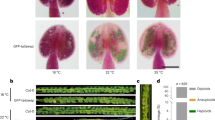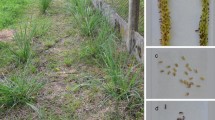Abstract
To study the influence of both pollen competition ability (PCA) and haploid induction rate (HIR) on heterofertilization, we used maize haploid inducers with different HIRs as male parents. For these experiments, maize plants underwent dual pollination, first by the inducers and then by self-pollination at different time intervals. We found that PCA strongly influenced heterofertilization, as measured by the resulting ratio of hybrid kernels to selfed kernels. When log10 (hybrid kernel/selfed kernel) was close to 0, i.e., when pollen from the different parents arrived at the embryo sac nearly simultaneously, the heterofertilization rate (HFR) was high. Haploid inducers with a high HIR, such as CAU5 and CAUB73, led to not only more haploids and embryo aborted kernels but also more heterofertilized kernels, as compared with a non-inducer or with a haploid inducer with a low HIR. We thus conclude that PCA is an important factor that affects HFR through polytubey. In addition, during maize haploid induction, abnormal fertilization could also contribute to heterofertilization, which may be due to fertilization recovery of kernels that otherwise would have been aborted at early stage.


Similar content being viewed by others
Abbreviations
- HIR:
-
Haploid induction rate
- PCA:
-
Pollen competition ability
- HFR:
-
Heterofertilization rate
- EmAK:
-
Embryo aborted kernel
- EmAR:
-
Embryo aborted kernel rate
- NIL:
-
Near-isogenic line
- MAS:
-
Molecular mark assisted selection
- SNP:
-
Single-nucleotide polymorphisms
- ZD958:
-
Single hybrid ZhengDan958
- WX:
-
Waxy corn inbred line
References
Barret P, Brinkmann M, Beckert M (2008) A major locus expressed in the male gametophyte with incomplete penetrance is responsible for in situ gynogenesis in maize. Theor Appl Genet 117:581–594
Beale KM, Johnson MA (2013) Speed dating, rejection, and finding the perfect mate: advice from flowering plants. Curr Opin Plant Biol 16(5):590–597
Beale KM, Leydon AR, Johnson MA (2012) Gamete fusion is required to block multiple pollen tubes from entering an Arabidopsis ovule. Curr Biol 22(12):1090–1094
Berger F, Hamamura Y, Ingouff M, Higashiyama T (2008) Double fertilization–caught in the act. Trends Plant Sci 13(8):437–443
Chen SJ, Song TM (2003) Identification haploid with high oil xenia effect in maize. Acta Agron Sin 29:587–590 (in Chinese)
Coe EH (1959) A line of maize with high haploid frequency. Am Nat 93(873):381–382
Collard BCY, Mackill DJ (2008) Marker-assisted selection: an approach for precision plant breeding in the twenty-first century. Philos Trans R Soc B 363(1491):557–572
Dong X (2014) Fine mapping of haploid induction rate gene qhir1 and marker assisted selection of qhir1 in haploid breeding in maize. Doctoral dissertation. China Agricultural University (in Chinese)
Dong X, Xu XW, Miao JK, Li L, Zhang DF, Mi XF, Liu CX, Tian XL, Melchinger AE, Chen SJ (2013) Fine mapping of qhir1 influencing in vivo haploid induction in maize. Theor Appl Genet 126(7):1713–1720
Dresselhaus T, Sprunck S (2012) Plant fertilization: maximizing reproductive success. Curr Biol 22(12):R487–R489
Gao S, Babu R, Lu YL, Martinez C, Hao ZF, Krivanek AF, Wang JK, Rong TZ, Crouch J, Xu YB (2011) Revisiting the hetero-fertilization phenomenon in maize. PLoS ONE 6(1):e16101
Gorbet DW, Weibel DE (1970) Hetero-fertllization in grain sorghum. Agronomy Abstracts, p 10. https://scholar.googleusercontent.com/scholar?q=cache:V-sunlxj9uYJ:scholar.google.com/+Hetero-fertllization+in+grain+sorghum.&hl=zh-CN&as_sdt=0,5
Guignard JL (1899) Sur les antherozoides et la double copulation sexuelle chez les vegetaux angiospermes. Rev Gén Bot 11:129–135
Higashiyama T, Yabe S, Sasaki N, Nishimura Y, Miyagishima SY, Kuroiwa H, Kuroiwa K (2001) Pollen tube attraction by the synergid cell. Science 293(5534):1480–1483
Jiang L, Ci JB, Cui XY, Zhang Y, Nan N, Li JZ, Yang WG (2014) Study on induction rate and doubling rate of maize haploid under different ecological conditions. J Jilin Agric Univ 36(2):139–143 (in Chinese)
Kasahara RD, Portereiko MF, Sandaklie-Nikolova L, Rabiger DS, Drews GN (2005) MYB98 is required for pollen tube guidance and synergid cell differentiation in Arabidopsis. Plant Cell 17(11):2981–2992
Kasahara RD, Maruyama D, Hamamura Y, Sakakibara T, Twell D, Higashiyama T (2012) Fertilization recovery after defective sperm cell release in Arabidopsis. Curr Biol 22(12):1084–1089
Kasahara RD, Maruyama D, Higashiyama T (2013) Fertilization recovery system is dependent on the number of pollen grains for efficient reproduction in plants. Plant Signal Behav 8(4):e23690
Kato A (1990) Heterofertilization exhibited by using highly haploid inducing line “Stock 6” and supplementary cross. Maize Genet Cooperation News Lett 64:109–110
Kato A (1999a) Induction of bicellular pollen by trifluralin treatment and occurrence of triploids and aneuploids after fertilization in maize. Genome 42(1):154–157
Kato A (1999b) Single fertilization in maize. J Hered 90(2):276–280
Li L, Xu XW, Jin WW, Chen SJ (2009) Morphological and molecular evidences for DNA introgression in haploid induction via a high oil inducer CAUHOI in maize. Planta 230(2):367–376
Liu CX, Li W, Zhong Y, Dong X, Hu HX, Tian XL, Wang LL, Chen BJ, Chen C, Melchinger AE, Chen SJ (2015) Fine mapping of qhir8 affecting in vivo haploid induction in maize. Theor Appl Genet 128(12):2507–2515
Márton ML, Cordts S, Broadhvest J, Dresselhaus T (2005) Micropylar pollen tube guidance by egg apparatus 1 of maize. Science 307(5709):573–576
Maruyama D, Hamamura Y, Takeuchi H, Susaki D, Nishimaki M, Kurihara D, Kasahara D, Higashiyama T (2013) Independent control by each female gamete prevents the attraction of multiple pollen tubes. Dev Cell 25(3):317–323
Maruyama D, Völz R, Takeuchi H, Mori T, Igawa T, Kurihara D, Kawashima T, Ueda M, Ito M, Umeda M, Nishiwaka S, Groß-Hardt R, Higashiyama T (2015) Rapid Elimination of the Persistent Synergid through a Cell Fusion Mechanism. Cell 161(4):907–918
Murray MG, Thompson WF (1980) Rapid isolation of high molecular weight plant DNA. Nucleic Acids Res 8:4321–4326
Nagasawa N, Hibara KI, Heppard EP, Vander Velden KA, Luck S, Beatty M, Nagato Y, Sakai H (2013) GIANT EMBRYO encodes CYP78A13, required for proper size balance between embryo and endosperm in rice. Plant J 75(4):592–605
Nanda DK, Chase SS (1966) An embryo marker for detecting monoploids of maize (Zea mays L.). Crop Sci 6(2):213–215
Nawaschin S (1898) Resultate einer Revision der Befruchtungsvorgange bei Lilium martagon und Fritillaria tenella. Извecтия Poccийcкoй aкaдeмии нayк. Cepия мaтeмaтичecкaя 9(4):377–382
Neuffer MG, Coe EH, Wessler SR (1997) Mutants of maize. CSHL Press, New York, USA
Ottaviano E, Sari-Gorla M, Villa M (1988) Pollen competitive ability in maize: within population variability and response to selection. Theor Appl Genet 76(4):601–608
Poddubnaya-Arnoldi VA (1960) Study of fertilization in the living material of some angiosperms. Phytomorphology 10(1):185–198
Prasanna BM, Chaikam V, Mahuku G (2012) Doubled haploid technology in maize breeding: theory and practice. CIMMYT
Prigge V, Melchinger AE (2012) Production of haploids and doubled haploids in maize. In: Plant cell culture protocols. Humana Press, Totowa, pp 161–172
Rademacher S, Sprunck S (2013) Down regulation of egg cell-secreted EC1 is accompanied with delayed gamete fusion and polytubey. Plant Signal Behav 8(12):e27377
Rhoades VH (1935) A study of fertilization in Zea mays. Cornell University, New York
Robertson DS (1984) A study of heterofertilization in diverse lines of maize. J Hered 75(6):457–462
Rotarenco V, Eder J (2003) Possible effects of heterofertilization on the induction of maternal haploids in maize. Maize Genet Cooperation Newslett 77:30
Sarkar KR, Coe EH (1971) Analysis of events leading to heterofertilization in maize. J Hered 62(2):118–120
Scott RJ, Armstrong SJ, Doughty J, Spielman M (2008) Double fertilization in Arabidopsis thaliana involves a polyspermy block on the egg but not the central cell. Mol Plant 1(4):611–619
Sprague GF (1929) Hetero-fertilization in maize. Science 69:526–527
Sprague GF (1932) The nature and extent of hetero-fertilization in maize. Genetics 17(3):358
Sprunck S, Dresselhaus T (2015) Three cell fusions during double fertilization. Cell 161(4):708–709
Wu CC, Diggle PK, Friedman WE (2013) Kin recognition within a seed and the effect of genetic relatedness of an endosperm to its compatriot embryo on maize seed development. Proc Natl Acad Sci 110(6):2217–2222
Xu XW, Li L, Dong X, Jin WW, Melchinger AE, Chen SJ (2013) Gametophytic and zygotic selection leads to segregation distortion through in vivo induction of a maternal haploid in maize. J Exp Bot 64(4):1083–1096
Yang WP, Zheng YL, Wu J (2008) Heterofertilization of the opaque-2 endosperm in maize. Hereditas 145(5):225–230
Zhang ZL, Qiu FZ, Liu YZ, Ma KJ, Li ZY, Xu SZ (2008) Chromosome elimination and in vivo haploid production induced by Stock 6-derived inducer line in maize (Zea mays L.). Plant Cell Rep 27(12):1851–1860
Zhao X, Xu XW, Xie HX, Chen SJ, Jin WW (2013) Fertilization and uniparental chromosome elimination during crosses with maize haploid inducers. Plant Physiol 163(2):721–731
Acknowledgements
This work was supported by Grants from The National Key Research and Development Plan—Maize heterosis utilization technology and creation of strong heterosis maize hybrid[s] (2016YFD0101200), and The Modern Maize Industry Technology System (CARS–02–09).
Author information
Authors and Affiliations
Corresponding author
Ethics declarations
Conflict of interest
The authors do not have any competing interest to declare.
Rights and permissions
About this article
Cite this article
Liu, C., Chen, B., Ma, Y. et al. New insight into the mechanism of heterofertilization during maize haploid induction. Euphytica 213, 174 (2017). https://doi.org/10.1007/s10681-017-1957-6
Received:
Accepted:
Published:
DOI: https://doi.org/10.1007/s10681-017-1957-6




